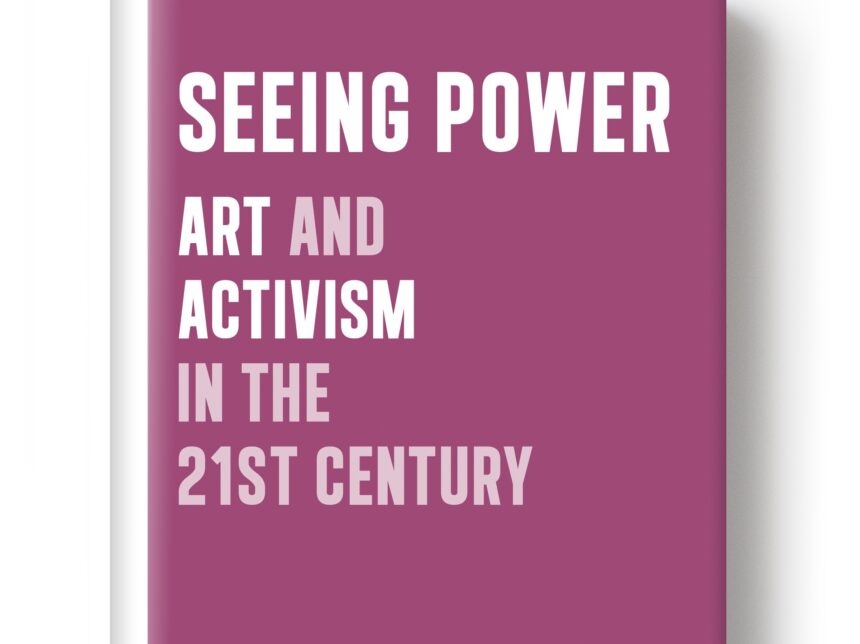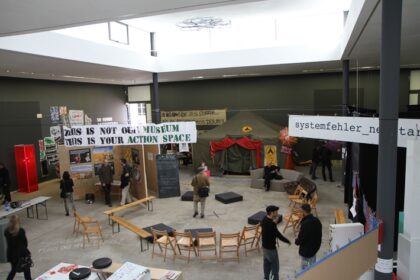The Inertia of Change: A review of Nato Thompson’s Seeing Power: Art and Activism in the 21st Century (Brooklyn and London: Melville House, 2015)
Hammam Aldouri
In Seeing Power: Art and Activism in the 21st Century, Nato Thompson, chief curator of the non-profit arts organization Creative Time, chronicles his direct involvement with, and retrospective reflections on, recent artistic initiatives that are increasingly becoming identified under the rubric of “socially engaged art.” At its most basic level, the book operates on two interconnected levels. First, it functions as an attempt to theoretically consolidate Thompson’s experiences as a curator, activist and collaborator in art projects over the course of the last twenty years. Second, the book is a contribution to the rapidly expanding field of literature on socially engaged art practice.
At a more refined level, Seeing Power can be said to present a distinct conception of socially engaged art, a conception that concerns practices that “self-consciously operate at the intersection of art and politics” (16). Thompson’s conception of socially engaged art rests, more precisely, on the unification of the conjunction “art and politics” in “the wild place we call art activism” (vii). Art activism is understood by Thompson in terms of modes of artistic strategies that transform our understanding of politics and ourselves in the very texture of the power dynamics that structure our everyday existence, that is, within the substance of the infrastructures of economic, political and technological networks that frame the ways in which we experience reality (vii, 36, 60, 81, 98, 109, 132, 143 and, in some sense, 137). In order to explore art activism, Thompson begins his book with a brief historical account of the absolute liquidation of viable modes of cultural resistance in advanced capitalist societies. Indeed, it is “in this fairly dismal moment – the moment of total and utter co-option” of alternative, anti-capitalistic modes of life, modes exemplified in the revolutionary impulses of the 1960s, that Thompson’s reflections commence (12). After establishing the historical setting in the first chapter, the book unfolds in six subsequent chapters, each one punctuated by explorations of recent artistic-activist projects such as Jeremy Deller’s It is What It Is: Conversations About Iraq (2009), the reconfiguration of the Occupy movement into the Occupy Museums movement (2011-ongoing) and Paul Chan’s Waiting for Godot in New Orleans (2007).
Importantly, Thompson tries to give some sense to the distinctively spatial politics of art activism. This idea underpins the theoretical and political thrust of his emphatic belief in the transformative power of art activism. What I mean by “spatial politics” is demonstrated in Thompson’s analysis of Chan’s Waiting for Godot in New Orleans. Thompson immediately draws our attention to the fact that the artist wanted to produce Samuel Beckett’s Waiting for Godot in a specific area: the Lower Ninth Ward and Gentilly, that is, within the areas most affected by the 2006 storm Hurricane Katrina. What is perhaps more significant in the spatial politics of Chan’s project is its commitment to “create a project that might actually alleviate the suffering of those affected by the storm” (109). A spatial politics, then, does not simply mean relocating an artistic project from one place to another in such a manner that the actual everyday life of the place of relocation remains auxiliary to the project. Rather, it embodies a sustained involvement with the everyday life of the area in which a project is actualized. In Chan’s case, this involved learning about the experiences of the people who lived in the areas most affected by the storm through a series of meetings over the course of several months. These meetings allowed the project to embed itself in the community in a way that allowed it develop a more concrete sense of the “extremely fraught series of relationships and political tensions that [constitute] a community” (110-11). With this embeddedness, the project evaded the problem of becoming simply another transitory and voyeuristic intervention, one that amounted to “disaster tourism” (109).
It is, I believe, at the point of the conjunction of spatial politics and social change that the problem with Thompson’s book emerges. In what follows, I will argue that Thompson’s reflections restrict the understanding of social change to an overly spatialized conception, one that, problematically, sets aside the question of the temporal character of social transformation.
In order to have a deeper understanding of Thompson’s spatialized understanding of social change, it is worth taking note of the two claims that structurally and conceptually bracket Thompson’s book: at the very beginning of the work, the author states that he will take a “geographic approach to ideas” (viii); and at the very end, we are reminded that, at bottom, “ideas are built in space and with resources” and, a fortiori, “space is where the battle is” (163). The necessity of underpinning the spatialized understanding of the conjunction of art and activism is that it “provides a way to think about power concretely, not just theoretically or abstractly” (159). Space allows us to come into contact with power in all its concrete reality since space is the most concrete of things.
It is the confluence of space and concrete reality that provides Thompson with the necessary standpoint to resolve the aporia that is putatively attached to socially engaged art, namely that of the irreconcilability of the autonomy of art and its direct social affect: “socially engaged artists deploy techniques of didacticism in order to make a work just legible enough, so that they can then engage a viewer in a level of ambiguity that will allow her to explore the work for herself” (35). This reconciliation is based on the production of spaces within pre-established spaces of legibility and illegibility (62). As we have seen, this is at work in Chan’s Waiting for Godot in New Orleans. Another example is Jeremy Deller’s It is What It Is. The project consisted of an “exhibition” of a car that had been demolished during an explosion in Baghdad during the Iraq War. Deller took the car, along with an American Iraq War veteran and an Iraqi refugee and artist, across the United States, displaying it in spaces such as town squares and college campuses. Not only does the work literally spatially re-locate an object from one context to another (from Baghdad to cities and towns across the United States), it also punctures a new space in the areas in which it is exhibited. This is succinctly expressed in the first sentence of the second chapter: “In 2009, the artist Jeremy Deller brought a piece of the Iraq War to America” (29).
And yet, can we think about the relation of art, activism and social change adequately if our reflections are restricted to its spatial dimensions? Thompson fails to sufficiently reflect on the temporality of the very task that it tries to articulate, that is, the way in which artistic initiatives can “truly change culture” (ix). That is to say, Thompson does not examine the temporal character of the process of change itself that is immanent to all modes of social change. This is odd to say the least, as change is a preeminently temporal category. More precisely put, Thompson’s overly spatialized focus yields from out of itself the shape of its misrecognized presupposition: Thompson de-temporalizes change because of the restricted understanding of the spatial relations of art activism. The upshot of this is unavoidable: the comprehension of socially engaged art alienates itself from the very principle it tries so hard to set up and revivify (social change).
There is a decisive point at which the de-temporalization (and re-spatialization) of time is staged in Thompson’s book. It appears at a moment in which the definition of the achievement of socially engaged art practices is disclosed: “[socially engaged art] can offer physical spaces of engagement over time. They are, in a sense, prolonged encounters of difference and affinity that transpire in the world and between people…They are somatic. They are lived” (145). This definition develops Thompson’s earlier identification of the task of socially engaged art as “the deployment of cultural forms and the production of political change” [52]. Socially engaged art practices produce spaces of transformative experiences that are contained in time. Time is, thus, defined as a mere vacant container in which events take place and are understood. Consequently, the dynamic of time is voided of any temporal character (the convergence and divergence of past, present and future) and, more precisely, is re-spatialized as an empty vessel in which things are placed (it was Socrates who, speaking of the structure of education, makes a distinction between spatialized learning and a temporal process of cultivation). Thus, the time of so-called somatic relations and transformations produced within these “prolonged encounters” is subsumed within a conception of time so empty of any ontological status that it renders the very processual dimension of the encounters – of what makes them decisively temporal – auxiliary, if not totally nugatory. Moreover, the temporal dimension of the potentiality of the artistic practices Thompson is trying to grasp, that is to say, the temporal character of their capacity to be able to offer alternative spaces is, likewise, stripped of its specific temporal character.
The consequences of this are, I believe, dire. A re-spatialized conception of time reduces any comprehension of the political core of socially engaged art to that of the realm of empirically demonstrable phenomena, that is, to a spatial realm in which the supposed transformations of society are verifiable through the senses (it is striking that “seeing” is the privileged mode of aesthetic experience in Thompson’s book). More problematically, the restriction of social change to its sheer spatial character reduces change to a pure present, that is, a spatialized apprehension of time that sets aside the temporal interconnection of past, present and future (a pure present suspends any relation to other temporal forms). Reduced to a spatialized pure present, the dynamics of change are hypostatized. This hypostatization is registered in the rhetoric of exigency that presuppose the politics of art activism. Once again, Chan’s project provides a paradigmatic example. In so far as it was carried out in the immediate aftermath of Hurricane Katrina, it oriented itself in response to what could be called the “ideology of here and now politics,” that is, a politics that engages directly with the present in its most immediate form. Captured within such an ideology, the promise of social change in socially engaged art becomes the mere shifting of the spatial elements that already form the configuration of the present, thus reproducing and recycling the elements that inform it, elements that allow us to immediately recognize it as the present in the first place. Reduced to a pure present, the practice of the artistic transformation of society has no relation either to the past or, more importantly, to the future since it is caught within the limits of the state of the present understood as a container in which events and transformations occur. As I have tried show, this strips social change of its temporal relation to that which is in the process of being produced, and is yet to be fully actualized.
The question of the status of change and, more precisely, of the temporal status of the potentiality of the actualization of change articulated by socially engaged art practices, is not only extremely complex, but it calls upon a philosophical legacy that is far more expansive than the historical purview of post-Hegelian Marxism that Thompson grounds his opening historical reflections in (since they are based in Aristotelian and Neo-Platonic philosophies, if not markedly earlier, in pre-Socratic, hylozoic philosophies). Thompson is not, of course, offering us a philosophical treatise on social change in his book. However, in the second sentence of the book, he does note that Seeing Power consists of an “unusual combination of philosophy and practice” (vii). Assuming that philosophy does not simply mean a general attitude or ethos, this suggests that there is a philosophical status to Thompson’s thoughts that needs to be taken more seriously. The lack of sustained philosophical work on the temporal dimension of social change understood through the structure and import of socially engaged art – resulting in a misleading de-temporalizing and re-spatializing concept of change – leads Thompson into further theoretical problems that his book touches on, but cannot adequately address. Although a detailed analysis of these problems far exceeds the scope of this review, I would nevertheless like to make brief note of two issues before concluding.
First, Thompson’s book does not allow us to reflect on the global nature of what is increasingly referred to as “global networks,” that is, of multidimensional modes of connectivity that move across geopolitical borders and, crucially, across different time zones. Thompson does not, for example, critical examine the transformative effects of an infrastructure such as the Internet. This is remarkably surprising since digital modes of production and reproduction are a constitutive feature of cultural practices in the very period that Thompson consciously locates his book, viz. the 21st century. What, for example, happens to the spatial dynamics of social relations produced in socially engaged art when their distinctively spatial character is inextricably permeated by the temporalities of digital communicational systems, that is, systems that eliminate the so-called “somatic” experience of given spatial zones by way of technologies that reduce social transactions to mere fractions of a second? Strangely, Thompson does not explore the relation of the explosive development of communication technologies to the dissolution of the “alt-globalization” (21) movement in the last few years of the twentieth century. (The last few years have seen a sharp increase in theoretical interest on the “alt-globalization” movement. The expression “alt-globalization” – short for “alternative-globalization and social justice movement” – is, in some sense, a unifying term that brings together a diverse number of social justice movements organized against the disastrous economic, social, political and ecological effects produced by increasingly deregulated and aggressively trans-national capitalist markets.) The Internet, one infers from reading Thompson, is simply a device that aids the agent that has learned to symbolically and economically profit from the aftermath of the liquidation of the alt-globalization movement: the “hipster” (24ff). The “hipster” is Thompson’s most deplored contemporary subject in so far as s/he embodies a kind of feckless, apolitical saunter through the cultural practices of advanced capitalist societies as if they were natural mediums in which one can realize one’s most spontaneous desires. Thompson avoids a more sustained reflection on the Internet precisely because it troubles the more immediate spatial sense of activist politics, that is, of a politics “characterized by aesthetic interventions, culture jamming, and a host of neo-Situationist tactical media approaches” that, at bottom, create “interventions in space” (22).
Second, the historical development of the United States and its place in the development of the history of the twentieth century (in the post-war context, especially) is not addressed at the adequate level of historical and critical analysis in Thompson’s book. This omission is perplexing given the privileged geopolitical place anchoring Thompson’s book: from the reflection of the American retail store “Hot Topic” (13) to the festivities of the Victorian Stroll organized by the city of Troy in the State of New York (147ff), Thompson’s thoughts are grounded in the United States. The evasion of a critical analysis of the geopolitical specificity of the United States fails to give the reader a clear sense of the distinctive nature of the nation’s temporal development as a peculiar paradigmatic case of the intensification of the capitalist mode of production. Arguably, the United States is a peculiar paradigm in that it is a distinctively atypical example in the history of the emergence of the social form of the nation-state. This weighs in immediately on a political activism that tries to reconfigure cultural practices in light of the historical failure of the “alt-globalization” movement. One could ask: what does the artistic actualization of social change amount to within a context in which the very social form of life has emerged from out of a frontier ideology that valorizes the self-actualization of the individual? Without an analysis of the historical development of the United States, we cannot come to understand the way in which its social-cultural forms are historically mediated.
In sum, Seeing Power operates as a useful and, in some sense, welcome introduction to anyone interested in establishing some preliminary coordinates to help navigate the rapidly expanding discourse on socially engaged art practices. I believe, however, that it has to be read with a certain caveat, one that Thompson does not himself provide. The caveat is that without an analysis of the temporal structure of the dynamics of change that give sense to what “social change” means, any claim made on the transformative effects of socially engaged art is either wholly misleading or, worse, a form of inert sloganeering masquerading as critical insight.
Hammam Aldouri holds a PhD in philosophy from the Centre for Research in Modern European Philosophy, Kingston University, London. He is currently a Helena Rubinstein Fellow in Critical Studies at the Whitney Museum of American Art Independent Study Program.











